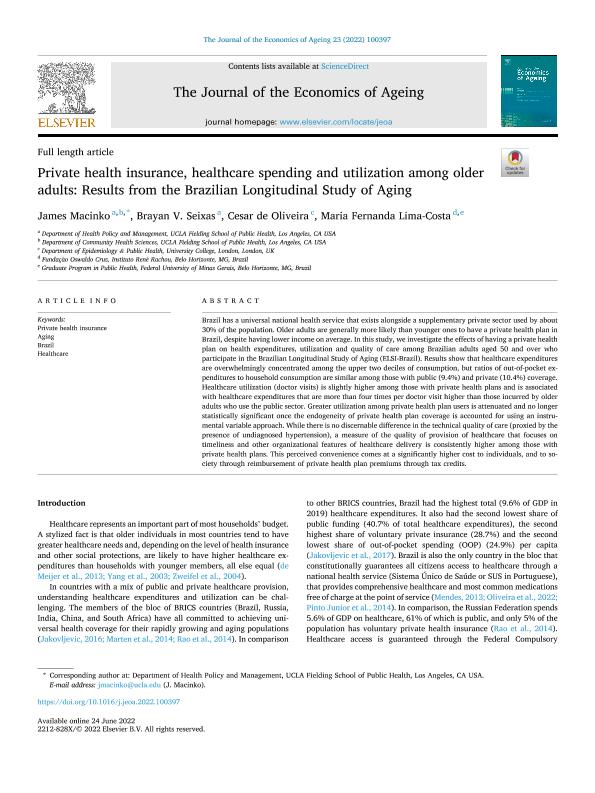Private health insurance, healthcare spending and utilization among older adults: Results from the Brazilian Longitudinal Study of Aging

Contenido multimedia no disponible por derechos de autor o por acceso restringido. Contacte con la institución para más información.
| Tag | 1 | 2 | Valor |
|---|---|---|---|
| LDR | 00000cab a2200000 4500 | ||
| 001 | MAP20220034203 | ||
| 003 | MAP | ||
| 005 | 20221121081214.0 | ||
| 008 | 221121e20221031esp|||p |0|||b|spa d | ||
| 040 | $aMAP$bspa$dMAP | ||
| 084 | $a344.1 | ||
| 245 | 0 | 0 | $aPrivate health insurance, healthcare spending and utilization among older adults: Results from the Brazilian Longitudinal Study of Aging$cJames Macinko...[et.el] |
| 520 | $aBrazil has a universal national health service that exists alongside a supplementary private sector used by about 30% of the population. Older adults are generally more likely than younger ones to have a private health plan in Brazil, despite having lower income on average. In this study, we investigate the effects of having a private health plan on health expenditures, utilization and quality of care among Brazilian adults aged 50 and over who participate in the Brazilian Longitudinal Study of Aging (ELSI-Brazil). Results show that healthcare expenditures are overwhelmingly concentrated among the upper two deciles of consumption, but ratios of out-of-pocket expenditures to household consumption are similar among those with public (9.4%) and private (10.4%) coverage. Healthcare utilization (doctor visits) is slightly higher among those with private health plans and is associated with healthcare expenditures that are more than four times per doctor visit higher than those incurred by older adults who use the public sector. Greater utilization among private health plan users is attenuated and no longer statistically significant once the endogeneity of private health plan coverage is accounted for using an instrumental variable approach. While there is no discernable difference in the technical quality of care (proxied by the presence of undiagnosed hypertension), a measure of the quality of provision of healthcare that focuses on timeliness and other organizational features of healthcare delivery is consistently higher among those with private health plans. This perceived convenience comes at a significantly higher cost to individuals, and to society through reimbursement of private health plan premiums through tax credits. | ||
| 650 | 4 | $0MAPA20080573867$aSeguro de salud | |
| 650 | 4 | $0MAPA20080568771$aEnvejecimiento | |
| 651 | 1 | $0MAPA20080637699$aBrasil | |
| 773 | 0 | $wMAP20210010194$g31/10/2022 Volumen 23 - 2022 , 10 p.$tThe Journal of the economics of ageing $dOxford : Elsevier ScienceDirect, 2021- |

